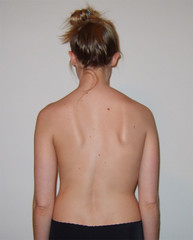What is a Scoliosis?
Scoliosis is a curvature of the spine in a sideways direction, measuring 10 degrees or more.It can be subdivided into a functional scoliosis which is a flexible spinal curvature caused by modifiable factors such as muscle spasm or leg length discrepancy or a structural scoliosis where the spine has a fixed deformity that can continue to progress with growth;

There are multiple causes of scoliosis in children and teenagers. These can include neurological disorders such as Cerebral Palsy or defects present at birth. In the majority of cases the cause of a scoliosis is unknown and is therefore referred to as Idiopathic Scoliosis
Adolescent Idiopathic Scoliosis
Adolescent idiopathic scoliosis, (AIS) is the most common form of idiopathic scoliosis, occurring in individuals aged 10- 18 years. Adolescent females are more likely to have a scoliosis and demonstrate more significant spinal curvature than males of a similar age. While very small curves are common and are of minimal to no significance, approximately 2% of girls have a curve which warrants observation by a medical practitioner as the grow and develop
There is some evidence to suggest that AIS may have a hereditary component, that can be passed on to females, however family members possessing a scoliosis may be generations apart. Children aged 10 years and older who have a female relative previously treated for scoliosis, have an increased risk of scoliosis and therefore require a spinal examination.
Medical Assessment
If you suspect that your child has a scoliosis your treating physiotherapist or General Practitioner will perform the following testing:
- Assess for asymmetry
- Shoulder height
- Waist height
- Thigh creases
- Observing for visible rib hump with forward bending
- Strength of lower limb muscles
- Reflexes
- Referral for X-ray (if required) to assess degrees of spinal curvature
Treatment 
If your child is diagnosed with a Scoliosis their treatment will depend on the following factors:
- The degree of spinal curvature (based on spinal X-ray)The amount of growth your child has left (based on spinal X-ray)
If your child has a small curve (less than 20 degrees) they will most likely require monitoring from a spinal surgeon to ensure there is no increase in spinal curvature as they grow. Children diagnosed with larger curves may need to be fitted for a spinal brace or require spinal surgery to prevent long term pain and physical deformity.
Conclusion
Scoliosis is a condition that can rapidly progress and change as a child grows and develops. Early detection is key in the management of scoliosis and minimising its long term impact on your child’s physical well being.
References
About Scoliosis- causes symptoms, treatment information for patients and parents. (n.d.). Retrieved from http://www.scoliosis-australia.org.
Kim, H., Blanco, J., & Widmann, R. (2009). Update on the management of idiopathic scoliosis. Current Opinion in Pediatrics, 21(1), 55-64.
Temby, S. (2014). Scoliosis and spinal surgery. Paediatric Physiotherapy Theory (PHTY 90013), University of Melbourne Australia.
Weinstein, S., Dolan, L., Spratt, K., Peterson, K., Spoonamore, M., & Ponseti, I. (2003). Health and function of patients with untreated idiopathic scoliosis. A 50 year natural history study.Journal of American Medical Association, 289(5), 559-567.


